Meet the Council: Unique Marketing Opportunities Bring More Profit to These Producers
The Beef Cattle Research Council (BCRC) is made up of producer members from across Canada, appointed by each of the provincial beef organizations that allocate part of the Canadian Beef Cattle Check-Off to research. The number of members from each province is proportional to the amount of provincial check-off allocated to research.
The following is part four in a series to introduce you to this group of innovative thinkers that set BCRC’s direction by sharing practices, strategies, or technologies that they have integrated into their own operations. Read part one, part two, and part three of this series. Regardless of what Canadian region beef producers are from, creative marketing strategies can help farmers profit as much as possible when they sell their cattle.
Working With Neighbours to Market Cattle

Ron Stevenson – Ontario
Ron and his family operate a 100 head commercial cow-calf operation in Walton, Ontario. Being located in the Great Lakes basin, rainfall is abundant in their area which is both a challenge and a benefit. Excess mud can cause animal health issues, especially in the springtime, but on the other hand, the Stevensons only need about 1.5-2 acres to support a cow-calf pair.
Ron and his wife both have off-farm jobs with Ron traveling extensively, splitting his time between Ontario and Alberta, in his role with Metzger Veterinary Services. Because of this, the farm must be fairly self-sufficient and set up in a way that most of the labour can be done on evenings and weekends.
The cow herd calves at the home place in late April. Pairs are kept at home through the calving season because springtime mud presents a challenge for both calf health and keeping cattle out on grazing pastures. After calving, pairs are then shipped to summer grazing pastures.
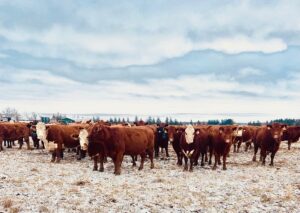
The pastures are set up with a good perimeter fence with easier to move portable fences to break the pasture into smaller interior paddocks, which cattle are rotated through every week. This allows Ron and his family to spend some extra time on the weekends moving cattle between paddocks and making sure cattle are all looked after while the family is home. Water is located in the centre of the field allowing all paddocks access. Near the water cattle also have creep feed for the calves, an oiler, and mineral for cows.
A downside of their location is the abundant snowfall that can sometimes limit the winter grazing practices that can be used. Grass is stockpiled at the home place all summer and when cows come home for wintering in late October, calves are sorted off and sold. The cows go directly to the stockpiled grass where they are rotationally grazed for at least a month. After that, cattle are fed free choice hay and a total mixed ration (TMR) developed using a least cost formulation which will usually contain corn silage, chopped straw, and vitamin mineral premix with monensin. Through his job in the veterinary industry, Ron has seen the disease control benefit that monensin can have and also feels it helps his cows maintain condition while overwintering.
Ron makes sure that free choice hay and shelter is provided at a distance from where they are feeding his cows the TMR to ensure that cattle stay fit and maintain a good body condition score though the winter months.
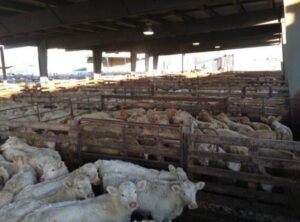
When it comes to marketing his cattle, Ron has a unique approach and is a member of the Bruce Peninsula Calf Club. Members of this club not only sell cattle together but follow similar management processes so that the calves can be sold in a uniform bunch.
Members of the club try to breed and calve around the same time as well as use similar vaccine protocols on all 1200 calves sold in the club’s presort sale. This approach provides buyers with a uniform group of cattle on sale day. With vaccinations and herd health being a top priority for members, the group of calves is seen as a reputation herd by buyers.
Members of the group keep records of calf performance and management practices. They also conduct a survey among the buyers to get an idea of how calves have performed in the feedlot as well as morbidity and mortality rates. This survey information is then shared back to the calf club members so they can use the data to make changes on their operations.
Diversity and Direct Marketing
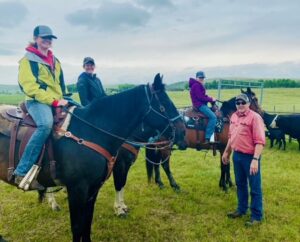
Graeme Finn – Alberta
Graeme, along with his wife Heather and two daughters own and operate Southern Cross Livestock, a cow-calf operation near Madden, Alberta. Taking care of the environment and sustainably raising beef has always been important to Graeme. Graeme was raised in Australia and credits programs there for starting his interest in sustainability.
At Southern Cross Livestock, cattle are grazed 365 days a year with no supplemental feed. A mineral pack that is formulated based on forage test results is the only thing provided to cattle while out on pasture. The majority of land that Graeme grazes is rented land. This works well for their operation, but Graeme says being clear about what is expected by both the renter and the land owner as well as having similar goals and expectations when it comes to land management and stewardship helps build a successful renting relationship.
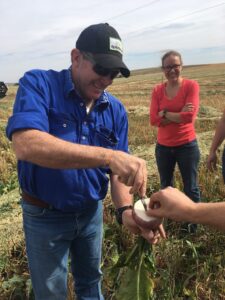
Diversity is a key focus for Graeme and Heather in all aspects of the operation. Graeme includes diversity of forages that have been seeded into his pastures (including plenty of flowering species as beekeepers also use their pastures for bees), uses diverse mixes with swath grazing, has diversity in investments, and has an off-farm job with his role of president of Union Forage. By including diversity into as many aspects of his operation as possible, Graeme says he is able to spread out the risk if something doesn’t work out as planned.
The cow herd calves on grass pastures that are either naturalized bluegrass or pastures that have been rejuvenated to include more legumes. The high legume pastures offer high quality grazing in early spring but can get muddy if there is too much rainfall, cattle are turned out to the bluegrass pastures in the case of pastures high rainfall and mud. A few weeks after calving, cows are moved to summer pasture.
Electric fencing is a huge part of Graeme’s operation, allowing larger pastures to be split up into smaller paddocks for grazing. Electric fencing also allows them more flexibility to make changes depending on the weather or other environmental conditions.
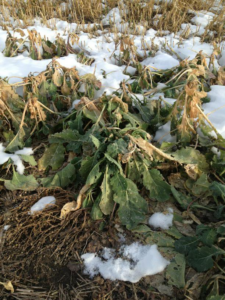
Cattle are moved through paddocks based on grass conditions. For example, in the spring when grass is growing very quickly, Graeme is moving the herd through the 20 to 25 acre paddocks much more quickly than they are in the late summer or fall. Graeme wants cattle to move fast enough to get through the paddocks while grass is still growing and palatable to cattle, but also aims to leave over half of the plant in the stand, to ensure it is able to regrow. By managing his pastures like this he has been able to move his summer grazing turn out dates three weeks earlier over the years due to more forage being available.
In the winter (November to mid April), cattle swath graze a forage mixture of triticale, oats, peas, forage rape, forage turnip, and sunflowers. This mixture is seeded together around May 20 and then swathed In the second week of September. Graeme performs soil tests each year to determine inputs needed for his swath grazing crop and has found that by using forage mixtures and practicing extended grazing, he has reduced his need for inputs. Graeme uses electric fence to move cattle through the swaths daily.
Graeme and Heather sell all of their cattle direct to consumers or feedlots. When selling directly to feedlots, Graeme credits his involvement in agriculture groups as well as Union Forage with his ability to meet other producers and hear what their needs are for cattle. Developing a network and establishing these relationships has helped him to direct market his feeder cattle to buyers. Since Southern Cross Livestock is VBP+ certified, Graeme targets feedlots who are also VBP+ certified so that cattle can remain in the program and buyers are aware of the record keeping and husbandry practices that are required.
Graeme also sells direct to consumers. To do this he sets up an agreement where the consumer buys a 12-month-old animal in spring and Graeme then takes on the responsibility of custom grazing that animal until October when it is finished and ready for butchering. From there the animals are sent to a local butcher where the consumer can choose how they want it butchered and pay for the cost. This program started out small but is growing through word of mouth from established customers. Graeme says the growth in his direct-to-consumer sales is mostly due to the large number of acreages in his area and his close proximity to cities.
Having multiple ways to market their cattle is one more way Graeme is adding diversity to his operation.
Stay tuned for the next installment in this series when we introduce you to another group of Council members and the management strategies and practices implemented on their operations.
Click here to subscribe to the BCRC Blog and receive email notifications when new content is posted.
The sharing or reprinting of BCRC Blog articles is welcome and encouraged. Please provide acknowledgement to the Beef Cattle Research Council, list the website address, www.BeefResearch.ca, and let us know you chose to share the article by emailing us at info@beefresearch.ca.
We welcome your questions, comments and suggestions. Contact us directly or generate public discussion by posting your thoughts below.